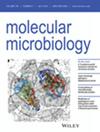在反硝化菌丝菌中,两个相关的硫酸盐-硫响应转录抑制因子调节硫代硫酸盐氧化,并对硝酸盐呼吸和厌氧生物合成产生深远影响
IF 2.6
2区 生物学
Q3 BIOCHEMISTRY & MOLECULAR BIOLOGY
引用次数: 0
摘要
细菌已经进化出多种策略来感知和响应诸如硫代硫酸盐等无机还原性硫化合物的可用性。在反硝化丝孢菌(一种专性化学有机异养α -变形菌)中,硫代硫酸盐作为补充电子供体的使用受到两个同源的磺胺-硫-响应ArsR -型转录抑制因子sHdrR和SoxR的调节。在这里,我们提供了关于sHdrR的分布和系统发育的信息,以及它的两个保守半胱氨酸在体内的相关性,并通过靶向qRT - PCR和基于RNA - Seq的全球分析来鉴定SoxR和sHdrR控制的基因。sHdrR和SoxR缺失分别影响165个和170个基因,其中138个基因重叠。SoxR调控硫代硫酸盐氧化和硫烷硫进入细胞质的sox基因,以及编码亚硫酸盐形成所必需的细胞质酶的lip - shdr - lbpA基因。sHdrR只影响这些基因的一个子集。sox基因的转录在缺少它的情况下保持不变。sHdrR和SoxR协同作用,它们的活动可能还涉及与其他转录调控因子的相互作用。最重要的是,sHdrR/SoxR调控的范围远远超出了硫氧化,并深刻影响了H.反硝化菌的厌氧代谢,特别是反硝化作用。本文章由计算机程序翻译,如有差异,请以英文原文为准。
In Hyphomicrobium denitrificans Two Related Sulfane‐Sulfur Responsive Transcriptional Repressors Regulate Thiosulfate Oxidation and Have a Deep Impact on Nitrate Respiration and Anaerobic Biosyntheses
Bacteria have evolved multiple strategies to sense and respond to the availability of inorganic reduced sulfur compounds such as thiosulfate. In Hyphomicrobium denitrificans sox genes for periplasmic thiosulfate oxidation and sulfane sulfur import into the cytoplasm, as well as the lip‐shdr‐lbpA genes encoding the cytoplasmic enzymes essential for sulfite formation. sHdrR affects only a subset of these genes. The transcription of sox genes remains unaltered in its absence. sHdrR and SoxR act cooperatively and their activity probably also involves interaction with other transcriptional regulators. Most importantly, sHdrR/SoxR regulation extends far beyond sulfur oxidation and deeply affects anaerobic metabolism, particularly denitrification in H. denitrificans
求助全文
通过发布文献求助,成功后即可免费获取论文全文。
去求助
来源期刊

Molecular Microbiology
生物-生化与分子生物学
CiteScore
7.20
自引率
5.60%
发文量
132
审稿时长
1.7 months
期刊介绍:
Molecular Microbiology, the leading primary journal in the microbial sciences, publishes molecular studies of Bacteria, Archaea, eukaryotic microorganisms, and their viruses.
Research papers should lead to a deeper understanding of the molecular principles underlying basic physiological processes or mechanisms. Appropriate topics include gene expression and regulation, pathogenicity and virulence, physiology and metabolism, synthesis of macromolecules (proteins, nucleic acids, lipids, polysaccharides, etc), cell biology and subcellular organization, membrane biogenesis and function, traffic and transport, cell-cell communication and signalling pathways, evolution and gene transfer. Articles focused on host responses (cellular or immunological) to pathogens or on microbial ecology should be directed to our sister journals Cellular Microbiology and Environmental Microbiology, respectively.
 求助内容:
求助内容: 应助结果提醒方式:
应助结果提醒方式:


